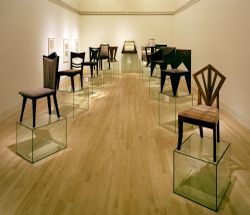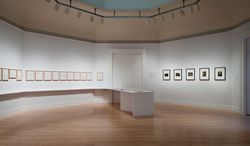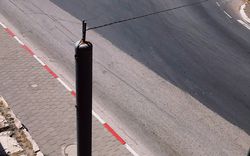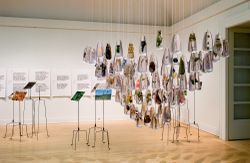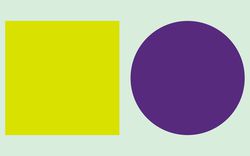archives
Niveau de description archivistique:
Fonds
Fonds Gene Summers
AP114
Résumé:
The Gene Summers fonds documents primarily the later part of Gene Summers' career as an architect, developer, artist and art collector. Summer's early work with the Office of Mies van der Rohe and C.F. Murphy Associates is summarily represented by notes, sketches and photographs.
1957 - 2004
Fonds Gene Summers
Actions:
AP114
Résumé:
The Gene Summers fonds documents primarily the later part of Gene Summers' career as an architect, developer, artist and art collector. Summer's early work with the Office of Mies van der Rohe and C.F. Murphy Associates is summarily represented by notes, sketches and photographs.
archives
Niveau de description archivistique:
Fonds
1957 - 2004
Enthousiasmés par les vues radicalement nouvelles de l’art cubiste, et animés par le désir d’introduire une esthétique entièrement différente et de manifester leur présence sur la scène politique, les cubistes tchèques ont créé non seulement des œuvres remarquables et visionnaires, mais ils sont passés de la théorie à la pratique. Le cubisme tchèque : architecture et(...)
Salles principales
10 juin 1992 au 2 août 1992
Le cubisme tchèque : architecture et design, 1910-1925
Actions:
Description:
Enthousiasmés par les vues radicalement nouvelles de l’art cubiste, et animés par le désir d’introduire une esthétique entièrement différente et de manifester leur présence sur la scène politique, les cubistes tchèques ont créé non seulement des œuvres remarquables et visionnaires, mais ils sont passés de la théorie à la pratique. Le cubisme tchèque : architecture et(...)
Salles principales
Projet
Quinta da Bela Flor, Lisboa
CD034.S1.1976.PR01
Description:
This project series contains one reproduction of a photograph displayed in the exhibit to document the Quinta da Bela Flor neighbourhood, in Lisbon, Portugal. The exhibit text explained that: Artur Rosa's project in the neighbourhood grew out of a shanty town, built on a difficult site, dating back to the 19th century, with reports of families living in hillside caves that today flank the entrance to a nearby highway. The process was based on voluntary work, and its ending presented a huge disappointment to the local brigade. In 1976 and 1977, Artur Rosa, also a practicing artist, produced three works that reflected on SAAL, its failure and the subsequent sense of persecution felt by many brigade leaders. The decision not to present the project but rather the artistic interventions aims at revealing the performative nature of the process, its poetic intensity and the way it related to its protagonists. In 1977 the architect presented a performance at the Fine Arts Society in Lisbon in which he closed the documentation of the project in a darkened room. The following year, he presented a structure with the documentation closed inside, and finally he used the project drawings in a collage with photographs on the occasion of the first public tap in Quinta da Bela-Flor. Those poetic artistic interventions are his form of publicly mourning the end of the SAAL process. (The SAAL Process, Housing in Portugal 1974–76) Artur Rosa worked for SAAL/Lisbon and Central South with Etelvina José, Hélio Oliveira, José Luís Teles Rebolo, José Miguel Fonseca, Luís Pereira, Manuel Coutinho Raposo, Maria Fernanda Carvalho, Maria Isabel Rodrigues Lobo, Nuno Blanco Bártolo, Nuno Martins and the residents' association Cooperativa de Habitação Económica Bela Flor, that was founded on February 13th, 1976. The project included 288 dwellings. The operation began in September 1976, with a construction date in December 1976. This project series contains a reproduction of a photograph of a model. The original photograph was produced around 1976 and was reproduced in 2015 for the exhibit.
circa 1976
Quinta da Bela Flor, Lisboa
Actions:
CD034.S1.1976.PR01
Description:
This project series contains one reproduction of a photograph displayed in the exhibit to document the Quinta da Bela Flor neighbourhood, in Lisbon, Portugal. The exhibit text explained that: Artur Rosa's project in the neighbourhood grew out of a shanty town, built on a difficult site, dating back to the 19th century, with reports of families living in hillside caves that today flank the entrance to a nearby highway. The process was based on voluntary work, and its ending presented a huge disappointment to the local brigade. In 1976 and 1977, Artur Rosa, also a practicing artist, produced three works that reflected on SAAL, its failure and the subsequent sense of persecution felt by many brigade leaders. The decision not to present the project but rather the artistic interventions aims at revealing the performative nature of the process, its poetic intensity and the way it related to its protagonists. In 1977 the architect presented a performance at the Fine Arts Society in Lisbon in which he closed the documentation of the project in a darkened room. The following year, he presented a structure with the documentation closed inside, and finally he used the project drawings in a collage with photographs on the occasion of the first public tap in Quinta da Bela-Flor. Those poetic artistic interventions are his form of publicly mourning the end of the SAAL process. (The SAAL Process, Housing in Portugal 1974–76) Artur Rosa worked for SAAL/Lisbon and Central South with Etelvina José, Hélio Oliveira, José Luís Teles Rebolo, José Miguel Fonseca, Luís Pereira, Manuel Coutinho Raposo, Maria Fernanda Carvalho, Maria Isabel Rodrigues Lobo, Nuno Blanco Bártolo, Nuno Martins and the residents' association Cooperativa de Habitação Económica Bela Flor, that was founded on February 13th, 1976. The project included 288 dwellings. The operation began in September 1976, with a construction date in December 1976. This project series contains a reproduction of a photograph of a model. The original photograph was produced around 1976 and was reproduced in 2015 for the exhibit.
Project
circa 1976
L’architecte portugais Álvaro Siza s’est rendu en 1995 au Pérou, emportant dans ses bagages, comme à l’accoutumée, quelques vêtements, quelques livres de poésie et un seul carnet de croquis. C’était là son nécessaire pour interpréter son voyage et l’intégrer dans son architecture. Plus d’un demi-siècle auparavant, le photographe péruvien Martín Chambi avait réalisé des(...)
Salle octogonale
26 janvier 2012 au 29 avril 2012
Alturas de Machu Picchu : Martín Chambi – Álvaro Siza à l'œuvre
Actions:
Description:
L’architecte portugais Álvaro Siza s’est rendu en 1995 au Pérou, emportant dans ses bagages, comme à l’accoutumée, quelques vêtements, quelques livres de poésie et un seul carnet de croquis. C’était là son nécessaire pour interpréter son voyage et l’intégrer dans son architecture. Plus d’un demi-siècle auparavant, le photographe péruvien Martín Chambi avait réalisé des(...)
Salle octogonale
archives
Niveau de description archivistique:
Fonds
Fonds Peter Carter
AP047
Résumé:
The Peter Carter fonds, 1943-1996, documents the professional career of architect Peter Carter. The largest portion of the archive corresponds to projects Carter completed as principal of the office, Peter Carter Architect (1974-96). Materials in this fonds consist of 7263 drawings (including reprographic copies), 2007 photographic materials, approximately 65 panels, 3 l.m. of textual records, 26 models, 1 enclosing unit, 1 carpet sample, 1 graphic design layout for stationery letterhead, 1 brown oak sample, 1 window sample, 1 sign, 1 carioca stone, 1 travertine block and 1 grey carpet tile.
1943-1996
Fonds Peter Carter
Actions:
AP047
Résumé:
The Peter Carter fonds, 1943-1996, documents the professional career of architect Peter Carter. The largest portion of the archive corresponds to projects Carter completed as principal of the office, Peter Carter Architect (1974-96). Materials in this fonds consist of 7263 drawings (including reprographic copies), 2007 photographic materials, approximately 65 panels, 3 l.m. of textual records, 26 models, 1 enclosing unit, 1 carpet sample, 1 graphic design layout for stationery letterhead, 1 brown oak sample, 1 window sample, 1 sign, 1 carioca stone, 1 travertine block and 1 grey carpet tile.
archives
Niveau de description archivistique:
Fonds
1943-1996
articles
Fictions de fictions
Fictions de fictions
Piper Bernbaum sur les réalités physiques et les fictions juridiques de l’érouv à Jérusalem
Actions:
Figurer un territoire
Environnement : manières d’agir pour demain s’attaque à des sujets d’actualité tels que la consommation d’énergie et les ressources naturelles, la question de limiter le contrôle de l’humanité sur l’environnement en raison de son immense capacité technologique, la recherche de ressources renouvelables et les meilleurs moyens pour les utiliser. À travers les travaux de(...)
Salles principales
18 octobre 2006 au 10 juin 2007
Environnement : manières d’agir pour demain
Actions:
Description:
Environnement : manières d’agir pour demain s’attaque à des sujets d’actualité tels que la consommation d’énergie et les ressources naturelles, la question de limiter le contrôle de l’humanité sur l’environnement en raison de son immense capacité technologique, la recherche de ressources renouvelables et les meilleurs moyens pour les utiliser. À travers les travaux de(...)
Salles principales
documents textuels
ARCH276059
Description:
7 files - Group contains: Union of Architects (UIA) correspondence; University courses etc.; Canada China Trade Council; Canadian Board of Practicing Architects; Architectural Institute of British Columbia (AIBC) registration lists; Royal Canadian Academy of Arts misc. correspondence; Gutheim Seelig Erickson.
ca. 1977-1979
Correspondence from various arts and architecture associations
Actions:
ARCH276059
Description:
7 files - Group contains: Union of Architects (UIA) correspondence; University courses etc.; Canada China Trade Council; Canadian Board of Practicing Architects; Architectural Institute of British Columbia (AIBC) registration lists; Royal Canadian Academy of Arts misc. correspondence; Gutheim Seelig Erickson.
documents textuels
ca. 1977-1979
archives
Niveau de description archivistique:
Fonds
Fonds Roland Dumais
AP005
Résumé:
The Roland Dumais fonds, 1930-1975, documents architect Roland Dumais’s design and construction of over 500 built projects in Québec. In addition to documenting Dumais’s professional career (1935-1971), the fonds includes materials relating to the everyday administration of Dumais’s architectural firm (1941-1977) as well as materials pertaining to his personal life (1932-1982). Materials in this fonds consist of approximately 12 400 drawings (including reprographic copies), 126 photographic materials, 10.33 l.m. of textual records, 5 models, and 3 reels of 16 mm film.
1930-1975
Fonds Roland Dumais
Actions:
AP005
Résumé:
The Roland Dumais fonds, 1930-1975, documents architect Roland Dumais’s design and construction of over 500 built projects in Québec. In addition to documenting Dumais’s professional career (1935-1971), the fonds includes materials relating to the everyday administration of Dumais’s architectural firm (1941-1977) as well as materials pertaining to his personal life (1932-1982). Materials in this fonds consist of approximately 12 400 drawings (including reprographic copies), 126 photographic materials, 10.33 l.m. of textual records, 5 models, and 3 reels of 16 mm film.
archives
Niveau de description archivistique:
Fonds
1930-1975
En complément de l’exposition L’architecte, autrement, Todd Rouhe et Rachel Himmelfarb, de la firme common room, présentent leur processus de travail en collaboration : « Cette question – Quel est le problème? – anime la méthode de travail de common room. Elle définit le processus de recherche, d’expérience, d’interaction et de communication qui non seulement influence(...)
Théâtre Paul-Desmarais
19 novembre 2015
common room : Quel est le problème?
Actions:
Description:
En complément de l’exposition L’architecte, autrement, Todd Rouhe et Rachel Himmelfarb, de la firme common room, présentent leur processus de travail en collaboration : « Cette question – Quel est le problème? – anime la méthode de travail de common room. Elle définit le processus de recherche, d’expérience, d’interaction et de communication qui non seulement influence(...)
Théâtre Paul-Desmarais
